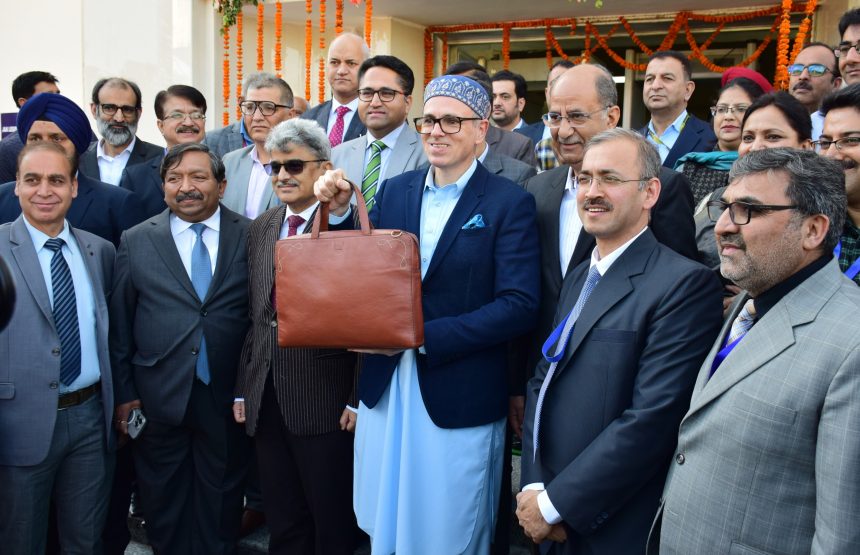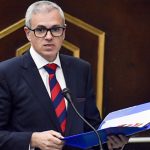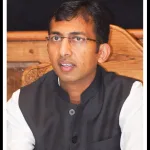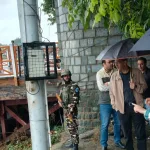In a historic moment for Jammu and Kashmir, Chief Minister and Finance Minister Omar Abdullah presented the Union Territories first budget under an elected government in seven years. With a strong commitment to usher in a new era of prosperity, Abdullah outlined a comprehensive roadmap aimed at boosting economic growth, fostering social inclusivity, and driving sustainable development.
Delivering his speech in the Legislative Assembly, Abdullah, who also holds the finance portfolio, praised Prime Minister Narendra Modi, Union Home Minister Amit Shah and Union Finance Minister Nirmala Sitharaman for their support in various sectors. He also expressed gratitude to the people of Jammu and Kashmir for their active participation in the recent assembly elections. The unprecedented voter turnout, he noted, reflected the people’s resolve to leave behind past challenges and embrace a future centered on development and progress.
He began his one-and-half-hour speech in English with a Persian couplet, “Tan Hama Daag Daag Shud – Punmba Kuja Kuja Neham…” (my entire body is covered with bruises where should I apply the balm), amid thumping of benches by his party legislators.
This is the first budget of the National Conference-led government after it came to power in October last year. The last budget session took place in 2018 under the then PDP-BJP government in the erstwhile state of J&K.
“This Budget is not just a financial statement; it is a blueprint for a self-reliant, prosperous Jammu and Kashmir,” Abdullah stated . He emphasised that the budget would focus on inclusive growth, fiscal discipline, and strategic investments in critical sectors such as infrastructure, agriculture, healthcare, education, and digital governance.
Key priorities include addressing regional disparities, empowering women and youth, and creating a conducive environment for investment and innovation. Abdullah also reiterated his commitment to restoring full statehood to Jammu and Kashmir, a long-standing aspiration of the people.
“My government is dedicated to strengthening grassroots democracy by empowering Panchayati Raj Institutions and Urban Local Bodies, which are vital to local governance and development. We are committed to holding elections for these bodies, further reinforcing our resolve to ensure accountable, inclusive, and decentralized governance.”
The Chief Minister presented an optimistic outlook for Jammu and Kashmir’s economy, which has experienced significant growth in recent years. The region’s economy expanded from ₹1.64 lakh crore in 2019-20 to ₹2.45 lakh crore in 2023-24. Building on this positive trajectory, Abdullah projected a GDP growth rate of 9.5% for 2025-26, confident that J&K will continue to grow and play a vital role in the vision of a developed India by 2047.”
However, fiscal challenges remain, with limited revenue streams covering only 30% of the state’s receipts, and salaries and pensions accounting for 60% of expenditure. To address this, Abdullah introduced several fiscal reforms, including improved tax compliance, especially under GST, and better management of non-tax revenues like e-Stamping.
The government also revealed that Jammu and Kashmir would receive ₹5,000 crore in central grants for the fiscal years 2024-25 and 2025-26, reinforcing the region’s infrastructure and fiscal reforms.
In terms of public sector reforms, Abdullah highlighted improvements in J&K Bank’s financial health, with operating profits projected to rise to ₹2,100 crore by 2025. Pension management systems have also been overhauled to ensure timely reimbursements, reducing reliance on short-term borrowing and moving towards long-term fiscal stability.
On the tax front, the state has seen significant improvements in GST compliance and non-tax revenues. For example, non-tax revenue reached ₹5,824 crore by January 2025. Additionally, reforms in the power sector aim to reduce transmission losses and under-recoveries, targeting a decrease from ₹5,244 crore in 2023-24 to ₹4,200 crore in 2024-25.
Addressing unemployment, Abdullah announced the launch of Mission YUVA, an initiative aimed at creating 137,000 enterprises and generating 425,000 jobs over the next five years. He emphasized that this would not only address unemployment but also provide skill development through programs like Mumkin, Tejaswani, and Spurring Entrepreneur.
The government has allocated ₹379.14 crore for employment and skill development, a significant increase from previous years. To further support the youth, the Jammu and Kashmir Skill and Entrepreneurship University (J&K SEU) will be established to provide specialized training in sectors such as technology, healthcare, and tourism.
To support tribal communities, Abdullah proposed the construction of 25 new hostels, 285 smart schools, and 6 Eklavya Model Residential Schools (EMRS). Additionally, livelihood generation programs for 2,000 tribal youth will be implemented.
To enhance the social security net, Abdullah announced increases in pension amounts for beneficiaries of the Integrated Social Assistance Scheme (ISSS) and National Social Assistance Programme (NSAP). The monthly pension will rise based on age: ₹1,250 for those under 60, ₹1,500 for those between 60 and 80, and ₹2,000 for those over 80. The total pension outlay will increase from ₹1,209 crore to ₹1,755 crore, benefiting over 10 lakh people.
In response to the increasing threat of natural disasters, the government will establish a ₹39 crore Disaster Mitigation Fund to address flood risks and Glacial Lake Outburst Floods (GLOFs). An additional ₹15 crore will be allocated to stabilize landslide-prone areas under the National Landslide Risk Mitigation Program (NLRMP).
The budget prioritizes infrastructure, with a focus on road, rail, and energy connectivity. Abdullah highlighted the Banihal bypass, which has reduced travel time between Srinagar and Jammu by 30 minutes, and the Delhi-Amritsar-Katra Expressway, which will cut travel time between Delhi and Katra to just six hours upon completion. The government plans to blacktop 4,000 km of roads and complete 150 road and bridge projects.
In energy, the region aims to harness 7,500 MW of additional hydroelectric power by 2027, with projects such as Pakal Dul, Kiru, and Uri-I Stage-II. The government has also committed ₹5,620 crore to modernize the energy distribution network and promote renewable energy with 22,494 solar panels on government buildings and 5,000 solar agricultural pumps.
The Jammu and Kashmir government will introduce a new hydropower policy to harness the full potential of 20,000 MW and attract private investment, Chief Minister Omar Abdullah announced on Friday. “To unlock J&K’s full hydropower potential, my government will introduce a new policy to accelerate development, attract investment, and promote sustainable energy growth,” said Abdullah.
He proposed a substantial Rs 2,021.37 crore allocation for the power sector in 2025-26, up from Rs 762.80 crore in 2024-25. The power sector, he noted, is critical to a thriving economy.
“Our vision is two-fold: first, to make J&K an energy hub, achieving self-sufficiency and becoming a net power exporter by harnessing its hydro potential; second, to ensure 24/7 reliable and affordable electricity for all households by 2027-28,” Abdullah added.
Although J&K has 20,000 MW of hydro potential, only 3,400 MW has been harnessed to date. The chief minister also highlighted challenges posed by high AT&C (Aggregate Technical and Commercial) losses, which have led to significant outstanding liabilities. To address this, Rs 28,000 crore were borrowed in recent years, increasing public debt from 48% of GSDP in FY 2015-16 to 52% in FY 2023-24.
“To mitigate this, we are reducing high-cost debt, optimising liabilities, and recalibrating repayment schedules for long-term fiscal stability,” Abdullah explained. He also pointed out that the Centre had sanctioned Rs 5,620 crore under the Revamped Distribution Sector Scheme (RDSS) to improve power distribution infrastructure, ensuring a reliable and financially sustainable supply. J&K has submitted an ambitious Rs 12,922 crore investment plan, focusing on smart metering, loss reduction, and modernising both rural and urban distribution networks.
Phase-I of the scheme is already underway, with over 40% progress on loss reduction works, and more than 40,000 smart meters installed. The government is also working to improve the aesthetics of Jammu and Srinagar by converting overhead electrical lines into underground cabling along major roads.
Additionally, the government is promoting rooftop solar installations under the PM Surya GharMuft Bijli Yojana, with solarisation of 22,494 government buildings set to be completed by December, generating a total capacity of 314 MW.
Abdullah acknowledged a key challenge: the gap between the cost of power supply and revenue collection. “While the average cost per unit is Rs 7, we only recover Rs 2.5 due to inefficiencies, high losses, and low tariffs. To bridge this gap, we are implementing 100% smart metering, strengthening billing and collection systems, and modernising the distribution network,” he said.
The government aims to reduce AT&C losses from 41% to 25% by 2025-26, ensuring a financially sustainable power sector.
Tourism continues to be a key driver of Jammu and Kashmir’s economy. With over 2.36 crore tourist visits in 2024, Abdullah announced new master plans for iconic destinations like Gulmarg, Pahalgam, and Sonamarg. To cater to growing demand, the government will expand registered homestays and introduce an Eco-Tourism Policy to make Jammu and Kashmir a world-class, sustainable tourism destination.
In a move towards more accountable and transparent governance, Abdullah emphasized the government’s strides in digital public service delivery. The e-Unnat portal now offers 1,166 online services, and platforms like JK SAMADHAN and RAABITA allow real-time grievance tracking and feedback. The government is also committed to 100% Aadhaar seeding for welfare disbursements, ensuring timely and transparent transfers for pensions and social benefits.
The estimated gross receipts for the fiscal year 2025-26 stand at ₹1,40,309.99 crore, with a fiscal deficit target of 3%. Abdullah’s government projects a 9.5% GDP growth for the year, reinforcing its commitment to a balanced and sustainable economic future.
The government is set to expand the Credit Guarantee Fund Trust for Micro and Small Enterprises (CGTMSE) and introduce initiatives like MSME Health Clinics and Skill Development Programs. Additionally, the promotion of Geographical Indication (GI) registration for handicrafts is expected to boost the global recognition of J&K’s traditional crafts, including pashmina and saffron.
The budget places a significant emphasis on sustainable resource extraction, with technology-driven initiatives like the use of satellite imagery for mining surveillance. This move is aimed at ensuring environmental sustainability while benefiting local communities.
Chief Minister Abdullah outlined an ambitious healthcare agenda, including the establishment of over 4,000 health facilities, the expansion of AIIMS campuses in Jammu and Kashmir, and the introduction of telemedicine services to improve access in remote areas. The SEHAT initiative will continue to provide free health insurance to residents, further enhancing the region’s healthcare coverage.
With a focus on building a future-ready workforce, the government plans to upgrade schools, create 15,000 pre-primary schools, and set up K-12 integrated schools. A substantial ₹1,388.97 crore allocation for school and higher education is expected to drive improvements in accessibility and quality.
The budget outlines significant investments in infrastructure, including road, rail, and air connectivity. Key projects include the development of highways and bridges, as well as the expansion of Jammu and Srinagar airports. The government is also focusing on urban development with green initiatives such as the operation of 200 electric buses in the region.
To ensure fiscal stability, the government plans to rationalize taxes on fossil fuels and vehicles purchased from outside the region. A 12% road/token tax will be introduced for new non-transport vehicles from outside Jammu & Kashmir. The target for GDP growth is set at 9.5% for the year, highlighting an ambitious yet achievable growth trajectory for the region.
A key focus of the budget is the expansion of digital governance. The number of online public services has surged from 60 to over 1,100, signaling the government’s commitment to digital transformation. The establishment of a Centre of Excellence for e-Governance will drive innovation in agriculture, healthcare, and cybersecurity.
The budget also emphasizes public-private partnerships (PPPs) as a means to accelerate development. Additionally, the social impact of these initiatives, including improvements in poverty reduction and gender equality, is expected to complement the region’s economic growth.
Later, the Chief Minister said that, “We want a vibrant press in J-K. The Press Club in Jammu is operational, but the Srinagar one is not. We will take steps to re-operationalise the Srinagar Press Club.”
Chief Minister Omar Abdullah’s budget for 2025-26 marks a transformative step in Jammu & Kashmir’s journey toward becoming a self-reliant, modern, and prosperous region. With targeted investments in infrastructure, education, healthcare, and digital governance, the government aims to foster sustainable growth, improve the quality of life for residents, and position the region as a key player in India’s economic landscape.
Budget 2025-26 Highlights
Economic Growth
9.5% GDP growth projected for FY 2025-26.
₹5,000 crore central grants for infrastructure and fiscal reforms.
Job Creation & Skill Development
137,000 enterprises and 425,000 jobs through Mission YUVA.
₹379.14 crore for skill development and new training institutes.
Tribal Welfare
25 new hostels and 285 smart schools for tribal communities.
2,000 youth to benefit from livelihood programs.
Healthcare Expansion
Over 4,000 health facilities and AIIMS campuses.
Expansion of telemedicine in remote areas.
Education
₹1,388.97 crore for education
15,000 pre-primary and K-12 schools to be built
Infrastructure
4,000 km of roads to be blacktopped.
Delhi-Amritsar-Katra Expressway to cut travel time to 6 hours.
Energy
7,500 MW additional hydroelectric power by 2027.
₹5,620 crore for energy network modernization and solar panels
Fiscal Reforms
GST compliance improvements and 12% road tax on new vehicles.
Disaster Management
₹39 crore for flood risk management and ₹15 crore for landslide stabilization.
Digital Transformation
Over 1,100 online services and a new Centre of Excellence for e-Governance.
Tourism
New plans for Gulmarg, Pahalgam, Sonamarg and National Water Sports Centre at Dal Lake
Eco-Tourism Policy and expanded homestays.
Social Welfare:
200 units of free electricity for AAY households and 10 kg of free ration per person.
- Marriage Assistance for EWS girls increased from ₹50,000 to ₹75,000
Pension Increase:
Monthly pensions raised for 1 million people under ISSS and NSAP schemes.
Sectoral allocations:
Agriculture: ₹2,221.58 crore.
Health: ₹1,750.50 crore.
Education: ₹1,388.97 crore.
Infrastructure: ₹4,062.93 crore for roads and bridges.
Judicial Infrastructure:
₹125 crore allocated for judicial infrastructure, with plans for a National Law University.
Tax Reforms:
12% road tax on vehicles from outside J&K to support local industries.
Stamp Duty exemption for property transfer within blood relations








